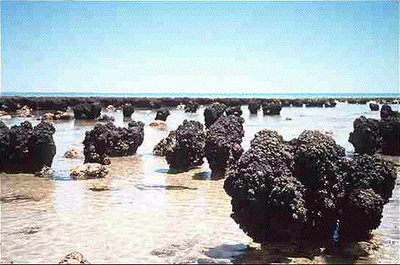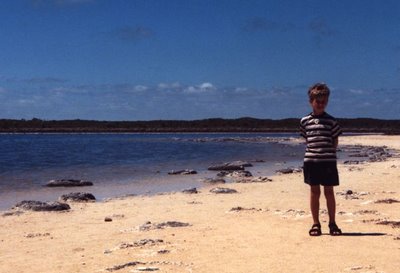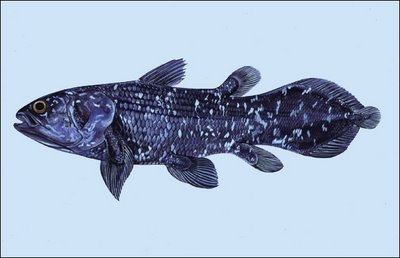Stromatolites in the News
One of the things that has been a constant in my many visits to Australia is stromatolites. I've managed to find some almost everywhere I've traveled in West Australia.
They captured my imagination on my first visit to WA. Fossilized microbes. The world's oldest living organism. Who wouldn't be excited? Well, most normal people, I suppose. But Christobel and I were excited by the prospect.
The WA Parks factsheet describes them thusly:
The stromatolites...look like rocky lumps strewn around the beach but are actually built by living organisms too small for the human eye to see. Within the structures are communities of diverse inhabitants with population densities of 3000 million individuals per square metre! The organisms use sediment and organic material to build stromatolites up to 1.5 metres high - up to 10 million times their size. Because they grow very slowly, a metre-high stromatolite could be about 2000 years old.According to a friend of Christobel's who does research in the field, several new stromatolite colonies have been discovered recently in WA.
When the Shark Bay stromatolites were discovered by scientists in 1956, they were the first growing examples ever recorded of structures, found fossilised in very old rocks, that had puzzled geologists for more than a century. The living microbes that built the stromatolites are similar to those found in 3500 million year old rocks, which are the earliest record of life on Earth.
This is what the Shark Bay stromatolites look like:
 Here is a photo of Tom standing near a small pool with stromatolites. They're not as impressive, but they are stromatolites all the same.
Here is a photo of Tom standing near a small pool with stromatolites. They're not as impressive, but they are stromatolites all the same.
Stromatolites are in the news today. According to the Chicago Tribune,
This microscopic branch of life — called archaea — likely has been thriving for about 3.4 billion years, according to new research from a team of Australian scientists. Writing in the journal Nature, they argue that miles of oddly shaped mounds of layered sedimentary rock found in Western Australia are not geologic features but the earliest fossil evidence of life on Earth.The Australians note that while most stromatolite colonies are just fossilized remains, some of those in WA are growing, and contain live bacteria.
The rocks, they say, are remnants of thriving microbial communities that dominated the world in the days when the young planet roiled with boiling oceans and the atmosphere was rich in ammonia and methane. Those conditions, while toxic to plants and animals, can nurture archaeans.
If the scientists are right, life arose on Earth within a billion years of its formation — very quickly in geologic time.
The findings are relevant to NASA's search for signs of life on Mars and other planets where conditions could support similar organisms.
"I think that these rocks are telling us that life probably arose ... rather quickly, which means that life only needs a short period of 'habitable' conditions on a planet in order to gain a foothold," said the study's lead author, Abigail Allwood of the Australian Centre for Astrobiology at Macquarie University in Sydney.
"The study gives me much more optimism that life could have gained a foothold early in the history of Mars, even if it were only briefly habitable."
Living fossils. Just like the Coelacanth.
 But not as pretty.
But not as pretty.


0 Comments:
Post a Comment
<< Home